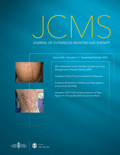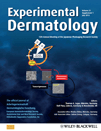
Dermatologic Therapy
Scope & Guideline
Empowering the dermatology community with vital research and reviews.
Introduction
Aims and Scopes
- Clinical Efficacy of Biologics and Other Systemic Treatments:
The journal frequently publishes studies evaluating the efficacy and safety of biologic treatments for conditions like psoriasis, atopic dermatitis, and hidradenitis suppurativa, providing insights from clinical trials and real-world data. - Innovative Therapeutic Approaches:
Research on novel treatments, including the use of JAK inhibitors, biologics, and photodynamic therapy, is a core focus, showcasing advancements and new strategies in managing dermatological diseases. - Patient-Centered Outcomes and Quality of Life Assessments:
Many articles explore the impact of dermatological conditions and treatments on patients' quality of life, using patient-reported outcomes to assess treatment satisfaction and effectiveness. - Dermatological Conditions and Comorbidities:
The journal addresses the relationship between dermatological diseases and systemic conditions, highlighting the need for comprehensive management strategies that consider comorbidities. - Emerging Trends and Technologies in Dermatology:
The journal covers cutting-edge research including the application of digital solutions, teledermatology, and artificial intelligence in dermatological practice, reflecting the evolving landscape of the field.
Trending and Emerging
- Real-World Evidence and Long-Term Safety Studies:
There is an increasing trend towards publishing studies that provide real-world evidence on the long-term safety and effectiveness of treatments, particularly biologics, as practitioners seek to understand outcomes outside of clinical trial settings. - Impact of COVID-19 on Dermatology:
Research examining the effects of COVID-19 on skin conditions, treatment adherence, and the implications of vaccination on dermatological diseases has surged, reflecting the pandemic's profound impact on healthcare. - Integration of Telemedicine in Dermatology:
The rise of teledermatology as a viable option for patient care has been a notable trend, with studies exploring its effectiveness, patient satisfaction, and the management of dermatological conditions remotely. - Personalized and Targeted Therapies:
There is growing interest in personalized medicine approaches, including the use of biomarkers to predict treatment responses and tailor interventions for individual patients, particularly in the context of psoriasis and atopic dermatitis. - Psychological and Quality of Life Assessments:
An increasing number of studies are focusing on the psychological impact of skin diseases and the importance of quality of life measures, indicating a trend towards a more holistic approach to dermatological care.
Declining or Waning
- Traditional Topical Therapies:
Research on conventional topical treatments, such as corticosteroids and retinoids, has decreased as attention shifts towards systemic therapies and biologics, which are viewed as more effective for severe conditions. - Historical Case Reports:
The journal has published fewer historical case reports and anecdotal evidence, favoring robust clinical studies and systematic reviews that provide stronger evidence for treatment efficacy. - Psychodermatology Studies:
Although psychodermatology remains relevant, the frequency of studies specifically addressing the psychological aspects of dermatological conditions has waned, potentially overshadowed by more clinical and pharmacological research. - Education and Awareness Campaigns:
There appears to be a reduction in articles focused on educational initiatives and public awareness campaigns regarding skin diseases, which may be less emphasized in the current literature. - Basic Science Research:
The journal has seen a decline in the publication of basic science studies, particularly those that do not directly translate into clinical practice, as there is a stronger focus on applied research and outcomes.
Similar Journals

Current Dermatology Reports
Advancing skin health through cutting-edge research.Current Dermatology Reports is a distinguished journal published by SPRINGER that focuses on the latest advancements and research in the field of dermatology. With an ISSN of 2162-4933, this journal provides a vital platform for clinicians, researchers, and students to disseminate groundbreaking findings and emerging trends pertinent to skin health. Notably recognized within the Q2 category in Dermatology for 2023, it ranks 50th out of 142 journals in the Scopus database, placing it in the 65th percentile among its peers. This accessible journal, which has been converging scholarly contributions since its establishment in 2012, plays a crucial role in bridging the gap between clinical practice and research, thereby enhancing patient care and advancing scientific understanding of skin-related issues. The editorial team is committed to the rigorous peer-review process, ensuring high-quality publications that reflect the evolving landscape of dermatology. Researchers and healthcare professionals are invited to contribute and engage with content that pushes the boundaries of knowledge in this dynamic discipline.

Journal of Cutaneous Immunology and Allergy
Uncovering the complexities of skin health and allergy science.The Journal of Cutaneous Immunology and Allergy, published by FRONTIERS MEDIA SA in Switzerland, is an esteemed Open Access platform dedicated to advancing research in the intersecting fields of dermatology, immunology, and allergy. Since its inception in 2018, this journal has provided a vital resource for the dissemination of innovative research findings and critical reviews, enhancing our understanding of cutaneous conditions related to immune responses. Although currently classified in the Q4 quartile in both Dermatology and Immunology & Allergy categories as of 2023, the journal continues to strive for recognition within the scientific community, encouraging collaboration and knowledge sharing among researchers, clinicians, and experts. The journal boasts an E-ISSN of 2574-4593 and is committed to making high-quality research freely accessible to all, thus fostering greater insights into the complexities of skin-related immune disorders. Join us in this journey to explore the forefront of cutaneous research and contribute to the evolving dialogue in this dynamic field.

AUSTRALASIAN JOURNAL OF DERMATOLOGY
Fostering scholarly dialogue in skin health.Australasian Journal of Dermatology is a leading publication in the field of dermatology, issued by Wiley since 1951, and reaching an audience of researchers, clinicians, and students interested in the latest advancements and practices in skin health. With an ISSN of 0004-8380 and an E-ISSN of 1440-0960, this journal stands out with its Q2 ranking in both Dermatology and Miscellaneous Medicine, positioning it within the top 61st percentile of its category according to Scopus. Although it does not provide Open Access options, Australasian Journal of Dermatology is committed to disseminating high-quality research that informs clinical practices and promotes scholarly dialogue. By publishing rigorous and peer-reviewed articles focused on various aspects of dermatological science, the journal plays a pivotal role in enhancing the dermatology community's understanding of skin conditions and treatments, making it an invaluable resource for professionals and students alike.

JOURNAL OF CUTANEOUS MEDICINE AND SURGERY
Exploring breakthroughs in cutaneous medicine and surgery.The Journal of Cutaneous Medicine and Surgery is a premier publication in the fields of dermatology and surgery, dedicated to advancing the scientific understanding of skin-related conditions and surgical techniques. Published by SAGE Publications Inc, this esteemed journal features a rich repository of peer-reviewed research, reviews, and clinical studies, ensuring that it remains at the forefront of dermatologic and surgical innovation. With an impressive impact factor and a ranking in the top quartile (Q1) of both dermatology and surgery categories for 2023, it is recognized as a vital resource for professionals, researchers, and students alike. The journal has consistently made significant contributions to the knowledge base that guides clinical practice and surgical decision-making, fostering a deeper understanding of the complexities involved in cutaneous medicine. For comprehensive updates, researchers can access this journal through SAGE’s platform, which supports the dissemination of high-quality research findings to a global audience.

JOURNAL OF DERMATOLOGICAL TREATMENT
Opening doors to groundbreaking dermatological discoveries.The JOURNAL OF DERMATOLOGICAL TREATMENT, published by TAYLOR & FRANCIS LTD, is a premier forum dedicated to advancing the field of dermatology through the dissemination of high-quality research. Since its inception in 1989, this journal has maintained a significant impact on the dermatological community, currently ranking in the top quartile (Q1) of the Dermatology category with an impressive Scopus ranking of #14 out of 142 journals, reflecting its reputation among peers and its contribution to the clinical and academic landscape. The journal shifted to Open Access in 2023, enhancing the accessibility of groundbreaking findings to researchers, clinicians, and students worldwide. With a commitment to publishing diverse articles, from innovative treatment modalities to comprehensive reviews, the JOURNAL OF DERMATOLOGICAL TREATMENT serves as an invaluable resource for professionals seeking to stay at the forefront of dermatological science in a rapidly evolving field.

DERMATOLOGIC CLINICS
Elevating Standards in Dermatologic Education and PracticeDERMATOLOGIC CLINICS is a leading journal in the field of dermatology, published by W B SAUNDERS CO-ELSEVIER INC. Since its inception in 1983, the journal has consistently provided a platform for the dissemination of high-quality research and clinical insights, earning its place in the prestigious Q1 quartile for dermatology in 2023. With a Scopus ranking of #34 out of 142 in its category and a commendable 76th percentile, DERMATOLOGIC CLINICS remains essential reading for clinicians, researchers, and students alike. The journal features comprehensive reviews and original articles that address the latest advancements and challenges in dermatologic diagnostics and treatments. Though it does not offer Open Access, it is widely accessible ensuring a broad readership. With a commitment to advancing the understanding of skin disorders, DERMATOLOGIC CLINICS continues to uphold its legacy of excellence in dermatological scholarship.

EXPERIMENTAL DERMATOLOGY
Elevating Standards in Biochemistry and DermatologyEXPERIMENTAL DERMATOLOGY, published by WILEY, is a leading journal in the fields of Biochemistry and Dermatology, with impressive rankings including Q1 status in both categories as of 2023. With its ISSN 0906-6705 and E-ISSN 1600-0625, the journal offers a reputable platform for disseminating cutting-edge research and insights into skin biology and related health issues. As a pivotal resource for professionals, researchers, and students alike, EXPERIMENTAL DERMATOLOGY includes a broad scope of topics, fostering a deeper understanding of dermatological conditions and enhancing new therapeutic strategies. The journal’s distinguished performance is highlighted by its Scopus rankings, which place it at the 91st percentile in Medicine-Dermatology and the 65th in Biochemistry. While not an open-access publication, the journal remains committed to ensuring the accessibility of crucial developments within the dermatological community worldwide, facilitating the advancement of both clinical practice and academic inquiry.

SKIN RESEARCH AND TECHNOLOGY
Elevating Knowledge in Skin Research and Clinical Practices.SKIN RESEARCH AND TECHNOLOGY, a distinguished publication by Wiley, stands at the forefront of dermatological science, emphasizing innovative research and technological advances in skin health. With an ISSN of 0909-752X and an E-ISSN of 1600-0846, this journal serves as a vital platform for researchers and professionals to present their findings and engage in discussions surrounding skin biology, clinical practices, and therapeutic technologies. As evidenced by its respectable Q2 ranking in the dermatology category for 2023 and a Q3 status in miscellaneous medicine, the journal attracts a broad readership and contributes significantly to the field. Housed in the United Kingdom with publications spanning from 1995 to 2024, SKIN RESEARCH AND TECHNOLOGY continues to foster innovation and knowledge dissemination in skin-related research. While its Access options are not open, the impact of the journal remains prominent, appealing to academic professionals and students eager to explore emerging trends and advancements in dermatological studies.

Annals of Dermatology
Advancing skin science for a healthier tomorrow.Annals of Dermatology is a prestigious academic journal published by the Korean Dermatological Association, focusing on the latest research and advancements in the field of dermatology. With a commitment to advancing knowledge in skin health and disease, this journal serves as a vital resource for researchers, clinicians, and students working in dermatology and related disciplines. Since its inception in 1989, it has evolved to consolidate its position in the academic community, boasting a Q2 ranking in the 2023 Dermatology category and a Scopus rank of #87 out of 142, placing it in the 39th percentile. Although it operates under a subscription model, the journal's impact factor reflects its significance in advancing dermatological research, attracting innovative studies and reviews that shape clinical practice. With a publication history extending from 1989 to 1996 and then from 2008 to the present, Annals of Dermatology continues to be an essential publication for those devoted to improving skin health.

JAMA Dermatology
Elevating Standards in Dermatological Science and Practice.JAMA Dermatology, an esteemed publication by the American Medical Association, is positioned at the forefront of dermatological research and clinical practice. With an ISSN of 2168-6068 and an E-ISSN of 2168-6084, this journal underscores a commitment to disseminating high-quality and impactful research within the field. Notably ranked Q1 in both Dermatology and Miscellaneous Medicine for 2023, JAMA Dermatology ranks among the top journals in its category, holding the impressive 3rd position out of 142 in Scopus's dermatology rankings, placing it in the 98th percentile. With converged years extending from 2013 to 2024, the journal emphasizes timely and critical advancements in dermatological science. Furthermore, as a champion of open access, it encourages a broad dissemination of knowledge, making essential research accessible to a wider audience. Researchers, professionals, and students alike will find JAMA Dermatology to be an invaluable resource for the latest findings, innovative therapies, and in-depth reviews that shape the future of dermatological health.